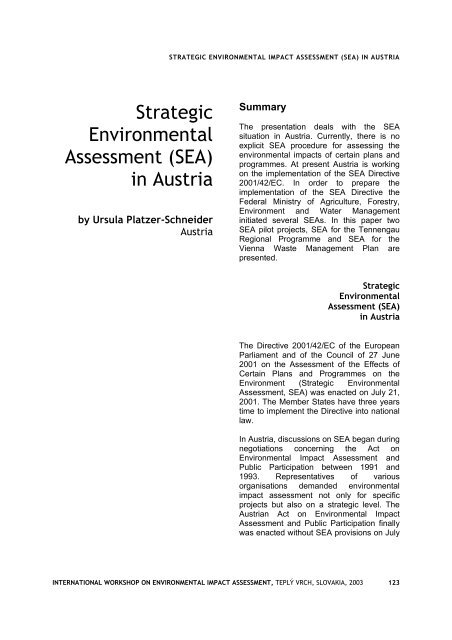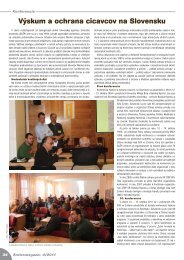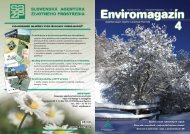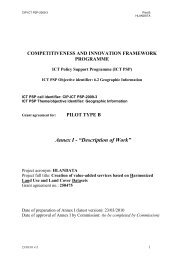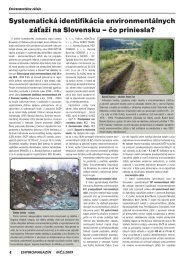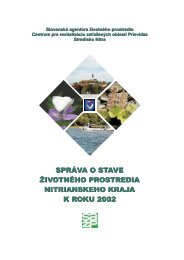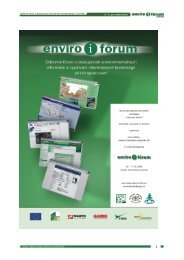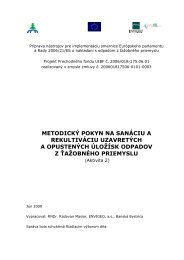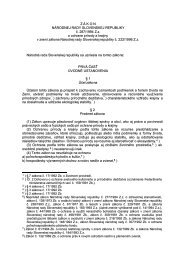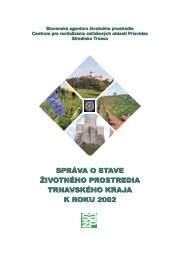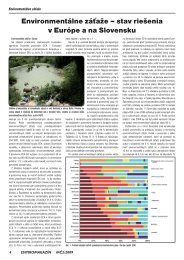Strategic Environmental Assessment (SEA) in Austria
Strategic Environmental Assessment (SEA) in Austria
Strategic Environmental Assessment (SEA) in Austria
- No tags were found...
Create successful ePaper yourself
Turn your PDF publications into a flip-book with our unique Google optimized e-Paper software.
STRATEGIC ENVIRONMENTAL IMPACT ASSESSMENT (<strong>SEA</strong>) IN AUSTRIA<strong>Strategic</strong><strong>Environmental</strong><strong>Assessment</strong> (<strong>SEA</strong>)<strong>in</strong> <strong>Austria</strong>by Ursula Platzer-Schneider<strong>Austria</strong>SummaryThe presentation deals with the <strong>SEA</strong>situation <strong>in</strong> <strong>Austria</strong>. Currently, there is noexplicit <strong>SEA</strong> procedure for assess<strong>in</strong>g theenvironmental impacts of certa<strong>in</strong> plans andprogrammes. At present <strong>Austria</strong> is work<strong>in</strong>gon the implementation of the <strong>SEA</strong> Directive2001/42/EC. In order to prepare theimplementation of the <strong>SEA</strong> Directive theFederal M<strong>in</strong>istry of Agriculture, Forestry,Environment and Water Management<strong>in</strong>itiated several <strong>SEA</strong>s. In this paper two<strong>SEA</strong> pilot projects, <strong>SEA</strong> for the TennengauRegional Programme and <strong>SEA</strong> for theVienna Waste Management Plan arepresented.<strong>Strategic</strong><strong>Environmental</strong><strong>Assessment</strong> (<strong>SEA</strong>)<strong>in</strong> <strong>Austria</strong>The Directive 2001/42/EC of the EuropeanParliament and of the Council of 27 June2001 on the <strong>Assessment</strong> of the Effects ofCerta<strong>in</strong> Plans and Programmes on theEnvironment (<strong>Strategic</strong> <strong>Environmental</strong><strong>Assessment</strong>, <strong>SEA</strong>) was enacted on July 21,2001. The Member States have three yearstime to implement the Directive <strong>in</strong>to nationallaw.In <strong>Austria</strong>, discussions on <strong>SEA</strong> began dur<strong>in</strong>gnegotiations concern<strong>in</strong>g the Act on<strong>Environmental</strong> Impact <strong>Assessment</strong> andPublic Participation between 1991 and1993. Representatives of variousorganisations demanded environmentalimpact assessment not only for specificprojects but also on a strategic level. The<strong>Austria</strong>n Act on <strong>Environmental</strong> Impact<strong>Assessment</strong> and Public Participation f<strong>in</strong>allywas enacted without <strong>SEA</strong> provisions on JulyINTERNATIONAL WORKSHOP ON ENVIRONMENTAL IMPACT ASSESSMENT, TEPLÝ VRCH, SLOVAKIA, 2003 123
STRATEGIC ENVIRONMENTAL IMPACT ASSESSMENT (<strong>SEA</strong>) IN AUSTRIA1, 1994. Currently, there is no explicit <strong>SEA</strong>procedure for assess<strong>in</strong>g the environmentalimpacts of certa<strong>in</strong> plans and programmes.In order to implement the requirements ofthe Directive <strong>in</strong> due time <strong>Austria</strong> is work<strong>in</strong>gon the implementation of the <strong>SEA</strong> Directive.This is rather difficult s<strong>in</strong>ce <strong>Austria</strong> is afederal state. Government responsibilitiesare thus shared by three levels of territorialauthority: The federation (Bund), the n<strong>in</strong>efederal prov<strong>in</strong>ces (Länder) and the localauthorities (Geme<strong>in</strong>den). The distribution ofmajor government responsibility betweenthe federation and prov<strong>in</strong>ces is determ<strong>in</strong>edby the Constitution. Some issues areentirely of the responsibility of the federation(e.g. water management); others rest solelywith the prov<strong>in</strong>ces (e.g. nature protection).In yet other areas, the federation isresponsible for legislation and the prov<strong>in</strong>cesfor adm<strong>in</strong>istration (environmental impactassessment – project level). The“fragmentation” of responsibility effects theimplementation of the Directive <strong>in</strong> a negativeway and has unsatisfactory impacts on theeffectiveness of an <strong>SEA</strong>.But it must be mentioned that <strong>in</strong> practice,some typical <strong>SEA</strong> steps can be foundalready <strong>in</strong> exist<strong>in</strong>g legislation or aresometimes used on a voluntary basis dur<strong>in</strong>gthe procedures for adopt<strong>in</strong>g plans orprogrammes. The legal requirements foradopt<strong>in</strong>g land use plans or programmesconta<strong>in</strong> environmental goals besides othertargets, which have to be taken <strong>in</strong>to accountdur<strong>in</strong>g the plann<strong>in</strong>g. The land use plann<strong>in</strong>gacts do not provide for a b<strong>in</strong>d<strong>in</strong>gexam<strong>in</strong>ation of alternatives or for elaborationof a <strong>SEA</strong> report. Nevertheless, the authoritywork<strong>in</strong>g out the plan or programme isobliged to prepare a documentation, whichusually considers environmental aspects. Ingeneral, the environmental authorities areconsulted dur<strong>in</strong>g the plann<strong>in</strong>g process.Public participation also takes place <strong>in</strong> landuse plann<strong>in</strong>g procedures, i.e. the concernedpublic is <strong>in</strong>vited to make comments on thedraft plan or programme.In order to prepare the implementation ofthe <strong>SEA</strong> Directive the Federal M<strong>in</strong>istry ofAgriculture, Forestry, Environment andWater Management <strong>in</strong>itiated several <strong>SEA</strong>s.One objective was to f<strong>in</strong>d out, which <strong>SEA</strong>steps can already be found <strong>in</strong> the exist<strong>in</strong>gplann<strong>in</strong>g procedures and how <strong>SEA</strong> <strong>in</strong>general can be <strong>in</strong>tegrated <strong>in</strong>to the exist<strong>in</strong>gplann<strong>in</strong>g process. Furthermore, practicalissues namely how to carry out <strong>SEA</strong>s wereof importance. In this paper two <strong>SEA</strong> pilotprojects are presented:<strong>SEA</strong> of the TennengauRegional Programme 1The Tennengau region is a rural area with13 municipalities. Accord<strong>in</strong>g to the SalzburgSpatial Plann<strong>in</strong>g Act of 1998, the regionalprogramme is to be drawn by the RegionalPlann<strong>in</strong>g Association, which is theassociation of the municipalities of theregion.Regional programmes establish goals andmeasures for certa<strong>in</strong> regions. They areb<strong>in</strong>d<strong>in</strong>g programmes, which also conta<strong>in</strong>non-b<strong>in</strong>d<strong>in</strong>g recommendations and solutionsfor regional spatial problems. Themunicipalities of such a region have to1 F<strong>in</strong>d more <strong>in</strong>formation <strong>in</strong>: Sommer Andreas,Platzer Ursula und Veichtlbauer Eva (2001)<strong>Strategic</strong> <strong>Environmental</strong> <strong>Assessment</strong>:Requirements and Experiences with theMethodology applied to the Tennengau RegionalProgramme, <strong>in</strong>: „Entwicklung, Planung undUmsetzung von Projekten nach europäischenMaßstäben. Salzburg nimmt Anteil am Wandel <strong>in</strong>Europa", SIR Mitteilungen und Berichte 29124INTERNATIONAL WORKSHOP ON ENVIRONMENTAL IMPACT ASSESSMENT, TEPLÝ VRCH, SLOVAKIA, 2003
STRATEGIC ENVIRONMENTAL IMPACT ASSESSMENT (<strong>SEA</strong>) IN AUSTRIAimplement the b<strong>in</strong>d<strong>in</strong>g measures by meansof local plann<strong>in</strong>g <strong>in</strong>struments. The keypr<strong>in</strong>ciples of the regional programmes arelaid down <strong>in</strong> the so-called model ofdevelopment, which comprisescommitments concern<strong>in</strong>g the pattern ofopen space and settlements.At the end of 1997 the Tennengau RegionalPlann<strong>in</strong>g Association decided to apply <strong>SEA</strong>accord<strong>in</strong>g to the <strong>SEA</strong> Proposal to theTennengau Regional Programme on avoluntary basis. The Salzburg Institute ofRegional Plann<strong>in</strong>g and Hous<strong>in</strong>g wascommissioned by the Tennengau RegionalPlann<strong>in</strong>g Association to work out theregional programme and by the FederalM<strong>in</strong>istry of Agriculture, Forestry,Environment and Water Management tocarry out the <strong>SEA</strong>.The plann<strong>in</strong>g and the <strong>SEA</strong> procedures weredone <strong>in</strong> close co-operation with thedepartments of spatial plann<strong>in</strong>g andenvironmental protection of the Prov<strong>in</strong>cialGovernment of Salzburg. The department ofenvironmental protection took over the partof the “environmental authority” accord<strong>in</strong>g tothe Directive.The requirements of the Directive were<strong>in</strong>tegrated <strong>in</strong>to the exist<strong>in</strong>g plann<strong>in</strong>g processs<strong>in</strong>ce some of the <strong>SEA</strong> aspects werealready covered. Additionally, it wasassumed that <strong>in</strong>tegrat<strong>in</strong>g <strong>SEA</strong> <strong>in</strong>to plann<strong>in</strong>gwould improve the plann<strong>in</strong>g process andbr<strong>in</strong>g the whole programme a step towardssusta<strong>in</strong>ability. Therefore, it was aimed by allrelevant plann<strong>in</strong>g and <strong>SEA</strong> actors to<strong>in</strong>tegrate environmental aspects from thevery start<strong>in</strong>g po<strong>in</strong>t. It was of primeimportance to broaden the <strong>SEA</strong> from an“assess<strong>in</strong>g” to an <strong>in</strong>tegrat<strong>in</strong>g <strong>in</strong>strument.At the beg<strong>in</strong>n<strong>in</strong>g of the year 2000 the <strong>SEA</strong>was f<strong>in</strong>ished and <strong>in</strong> May 2001 theTennengau Regional Plann<strong>in</strong>g Associationforwarded the proposal for the RegionalProgramme to the Prov<strong>in</strong>cial Government ofSalzburg as the competent authority. F<strong>in</strong>ally,<strong>in</strong> 2002 the Programme was formallyadopted.MethodologyFor the systematic and comprehensiveassessment of possible environmentalimpacts of the regional programme, some ofthe exist<strong>in</strong>g experiences with environmentalimpact assessments were applied. Thefollow<strong>in</strong>g ma<strong>in</strong> steps were carried out:AlternativesFor each b<strong>in</strong>d<strong>in</strong>g plann<strong>in</strong>g measure threealternatives were considered: two plann<strong>in</strong>gand a zero alternative. The two plann<strong>in</strong>galternatives were not designed as extremeoptions. Both were realistic possibilities withdifferent levels of compromises concern<strong>in</strong>genvironmental protection.Scop<strong>in</strong>gThe framework of the analyses wasdeterm<strong>in</strong>ed at the beg<strong>in</strong>n<strong>in</strong>g of the plann<strong>in</strong>gprocess and <strong>in</strong>cluded human be<strong>in</strong>gs, fauna,flora, soil, water, air, climate, landscape,material assets and cultural heritage.<strong>Environmental</strong> reportAn environmental report was prepared bythe Salzburg Institute of Regional Plann<strong>in</strong>gand Hous<strong>in</strong>g <strong>in</strong> close co-operation with thedepartment of environmental protection.This department co-ord<strong>in</strong>ated variousexperts from the Prov<strong>in</strong>cial Government ofINTERNATIONAL WORKSHOP ON ENVIRONMENTAL IMPACT ASSESSMENT, TEPLÝ VRCH, SLOVAKIA, 2003 125
STRATEGIC ENVIRONMENTAL IMPACT ASSESSMENT (<strong>SEA</strong>) IN AUSTRIASalzburg. These experts were consultedand had the possibility to express theirop<strong>in</strong>ions concern<strong>in</strong>g the report. The reportconta<strong>in</strong>s <strong>in</strong>formation referred to <strong>in</strong> the Annexof the <strong>SEA</strong> Directive. Of special <strong>in</strong>terest arethe follow<strong>in</strong>g issues:<strong>Environmental</strong> Quality ObjectivesIn addition to the spatial plann<strong>in</strong>g objectives,e.g. listed <strong>in</strong> the Salzburg Spatial Plann<strong>in</strong>gAct, also environmental objectives wereestablished. A system of environmentalquality objectives was elaborated conta<strong>in</strong><strong>in</strong>gobjectives and standards for theenvironmental quality as well asenvironmental <strong>in</strong>dicators. Theseenvironmental quality objectives wereadopted by the Tennengau RegionalPlann<strong>in</strong>g Association and became part ofthe assessment.Framework for Impact <strong>Assessment</strong>sFor each environmental quality objective thepossibilities for the assessment weredef<strong>in</strong>ed by a scale with five levels, i.e. it wasdef<strong>in</strong>ed by means of <strong>in</strong>dicators when theeffects of the planned measures were to bejudged as very negative, negative, with noeffect, positive or very positive.<strong>Assessment</strong>For each plann<strong>in</strong>g measure and thealternatives the assessment <strong>in</strong>cluded theprimary and secondary, positive andnegative effects on the different factorsdeterm<strong>in</strong>ed by the scop<strong>in</strong>g. It was carriedout by means of matrices and based on thesystem of environmental quality objectivesand on the framework for the environmentalimpact assessment mentioned above. Thiswas an essential prerequisite for the f<strong>in</strong>alstep of an <strong>in</strong>tegrative assessment.The assessment was carried out bynumerous experts cover<strong>in</strong>g the differentrequired doma<strong>in</strong>s. Furthermore, mitigationmeasures were worked out and documentedfor each plann<strong>in</strong>g measure.Integrated ApproachIn addition to the sectoral assessments bythe experts, for each plann<strong>in</strong>g measure an<strong>in</strong>tegrated assessment was carried outconsider<strong>in</strong>g for example <strong>in</strong>teractions, theprobability, duration, frequency andreversibility of the effects or the cumulativenature of the effects. A questionnaire wasworked out to support <strong>in</strong>tegratedassessment.On the basis of the sectoral and <strong>in</strong>tegratedassessment the environmental authorityworked out a matrix giv<strong>in</strong>g an overview ofthe outcome, i. e. the assessments of theplann<strong>in</strong>g measures <strong>in</strong>clud<strong>in</strong>g thealternatives. It illustrated each plann<strong>in</strong>gmeasure and its impacts on the differentfactors assessed with very negative,negative, with no effect, positive or verypositive.Conclusions and RecommendationsFirst of all, the pilot project showed that therequired <strong>SEA</strong> steps of the <strong>SEA</strong> Directive,which were not covered by the exist<strong>in</strong>gplann<strong>in</strong>g act could be <strong>in</strong>tegrated <strong>in</strong>to theplann<strong>in</strong>g procedure. The process orientedmodel, which enabled the participation andco-ord<strong>in</strong>ation of all relevant actorsconcerned from the beg<strong>in</strong>n<strong>in</strong>g wasnecessary and important.126INTERNATIONAL WORKSHOP ON ENVIRONMENTAL IMPACT ASSESSMENT, TEPLÝ VRCH, SLOVAKIA, 2003
STRATEGIC ENVIRONMENTAL IMPACT ASSESSMENT (<strong>SEA</strong>) IN AUSTRIAThis process oriented model alsostrengthened the role of the <strong>SEA</strong> itself andsupported the <strong>in</strong>tegrative aspect of <strong>SEA</strong>.The <strong>in</strong>volved municipalities and experts fromthe environmental authority used theprocess to present their arguments and tosolve conflicts.Furthermore, the system of environmentalquality objectives enabled a transparent andcomprehensive assessment, whichsupported the <strong>in</strong>tegration of environmentalaspects <strong>in</strong>to the plann<strong>in</strong>g. <strong>SEA</strong> contributedto improve the quality of the alternatives forthe b<strong>in</strong>d<strong>in</strong>g measures of the programme. Inaddition, due to their early <strong>in</strong>volvement,some very helpful recommendations by theenvironmental experts became part of theregional programme. F<strong>in</strong>ally, <strong>SEA</strong> could becarried out without significant additional timeand with reasonable f<strong>in</strong>ancial and humanresources.On the other hand, it has to be mentionedalso that the pilot project has to be seendifferentiated concern<strong>in</strong>g the considerationof the <strong>SEA</strong> results. The <strong>SEA</strong> was carried outon a voluntary basis and severalrecommendations and measures, whichwere put forward due to the <strong>SEA</strong> were takenout of the f<strong>in</strong>al proposal.<strong>SEA</strong> for the Vienna WasteManagement PlanThe Vienna Municipal Department 48 forWaste Management, the Vienna MunicipalDepartment 22 for <strong>Environmental</strong> Protectionand the Vienna Environment Counselconducted a <strong>SEA</strong> for the Vienna WasteManagement Plan. It was the first wastemanagement-related<strong>SEA</strong> <strong>in</strong> <strong>Austria</strong>. Thegoal and purpose of the <strong>SEA</strong> was to jo<strong>in</strong>tlyf<strong>in</strong>d the best ecological and economicsolution for the management of Vienna'swaste until the year 2010. Fundamentalquestions concern<strong>in</strong>g needs andtechnologies for the specific situation of theViennese waste management should beanswered. <strong>Environmental</strong> concerns shouldbe taken <strong>in</strong>to account equally as social andeconomic aspects dur<strong>in</strong>g the preparation ofthe plan. The model of "<strong>SEA</strong> at the roundtable" was developed and tested <strong>in</strong> thisprocess."<strong>SEA</strong> at the round table"The application of this new model was oneof the special aspects of the <strong>SEA</strong> for theVienna Waste Management Plan. "<strong>SEA</strong> atthe round table" means, that the <strong>SEA</strong> andthe plann<strong>in</strong>g of the Waste Management Planwere conducted as a team-process, wheremembers of the concerned authorities(<strong>in</strong>clud<strong>in</strong>g the environmental authorities),representatives of the public (the so called"qualified public") and external expertsparticipated on an equal basis <strong>in</strong> one team(so-called <strong>SEA</strong> team). As representatives ofthe public the Vienna Environment Counsel,who has launched the <strong>SEA</strong>, and severalenvironmental NGOs took part <strong>in</strong> theprocess. The <strong>SEA</strong> team developed theViennese Waste Management Plan togetherand was able to reach a consensus <strong>in</strong> mostof the questions. The <strong>SEA</strong> team wasresponsible for every <strong>SEA</strong> and plann<strong>in</strong>g stepdur<strong>in</strong>g the whole process. For this purposeseveral one or two day workshops werecarried out, dur<strong>in</strong>g wich different projectsteps were carried out <strong>in</strong> teamwork. Thiscooperative and participative approachshould make sure, that the best solution forthe management of Vienna's waste wasfound on the basis of a broad consensus,which considered the different <strong>in</strong>terests. Thecommon solution reached should be wellsupported by all the participants and havethe chance to get efficiently implemented.INTERNATIONAL WORKSHOP ON ENVIRONMENTAL IMPACT ASSESSMENT, TEPLÝ VRCH, SLOVAKIA, 2003 127
STRATEGIC ENVIRONMENTAL IMPACT ASSESSMENT (<strong>SEA</strong>) IN AUSTRIA<strong>SEA</strong> and Plann<strong>in</strong>g Elements for theVienna Waste Management PlanThe <strong>SEA</strong> and plann<strong>in</strong>g process comprisedthe follow<strong>in</strong>g elements, which were carriedout by the ”round table” <strong>in</strong> teamwork.Def<strong>in</strong>ition of the goalsGoals were def<strong>in</strong>ed for the Vienna wastemanagement until 2010. Wastemanagement goals like waste m<strong>in</strong>imisation,a self-sufficient waste disposal system forVienna, sav<strong>in</strong>g of landfill space, etc. andexplicit environmental goals like reduction ofgreenhouse gas emission, sav<strong>in</strong>g of energy,removal of pollutants from the ecospherewere taken up <strong>in</strong>to the Waste ManagementPlan.Development of alternative actions(so-called scenarios)Different <strong>in</strong>dividual measures (e.g. wastem<strong>in</strong>imisation, specific waste treatmentfacilities) were comb<strong>in</strong>ed <strong>in</strong>to packages ofmeasures. The aim was to compare entirepackages of measures that comprise awhole waste management system. Thescenarios conta<strong>in</strong>ed both preventivemeasures (waste m<strong>in</strong>imisation measures)and end of pipe measures (e.g. fermentationplants, waste <strong>in</strong>c<strong>in</strong>erators, mechanicalbiologicalwaste treatment facilities).Determ<strong>in</strong><strong>in</strong>g the scopeIn the scope phase the issues, which shouldbe assessed, the assessment method andthe <strong>in</strong>dicators for the assessment weredeterm<strong>in</strong>ed. Orig<strong>in</strong>ally 60 <strong>in</strong>dicators weredef<strong>in</strong>ed, which were f<strong>in</strong>ally reduced to 15 to20.Analysis and assessment of the scenariosThe different scenarios were compared toeach other and the effects of the <strong>in</strong>dividualscenarios were <strong>in</strong>vestigated to f<strong>in</strong>d outwhich options were better and which wereworse. The comparison took <strong>in</strong>to accountecological, social and economic impact.Development of a “consensus scenario”A “consensus scenario” was agreed on bythe round table as the best option from aholistic po<strong>in</strong>t of view. This scenario wasf<strong>in</strong>ally recommended for adoption to theVienna City Council for approval.Draft environmental reportA draft environmental report was produced,which compromised the results of the stepstaken so far <strong>in</strong>clud<strong>in</strong>g the assessment andthe documentation of the process. Thereport was written by the process manager.Carry<strong>in</strong>g out consultationThe members of the round table althoughbe<strong>in</strong>g actively <strong>in</strong>volved <strong>in</strong> all the <strong>SEA</strong> andplann<strong>in</strong>g elements so far had the possibilityto forward written comments, which wereattached to the f<strong>in</strong>al environmental report.F<strong>in</strong>al environmental reportIn reaction of the comments some changeswere necessary. The environmental reportand a proposal for a Vienna WasteManagement Plan (=consensus scenario)were submitted to the Vienna City Council.Adoption of the plan <strong>in</strong>clud<strong>in</strong>gmonitor<strong>in</strong>g measures128INTERNATIONAL WORKSHOP ON ENVIRONMENTAL IMPACT ASSESSMENT, TEPLÝ VRCH, SLOVAKIA, 2003
STRATEGIC ENVIRONMENTAL IMPACT ASSESSMENT (<strong>SEA</strong>) IN AUSTRIAF<strong>in</strong>ally, the consensus scenario <strong>in</strong>clud<strong>in</strong>gspecific monitor<strong>in</strong>g measures was approvedby the Vienna City Council.Conclusions and recommendationsAfter f<strong>in</strong>ish<strong>in</strong>g the Viennese <strong>SEA</strong> process,the <strong>SEA</strong> was evaluated us<strong>in</strong>g quality criteriaand the experience was documented 2 . Fromthe participants´ comments and the processmanager’s po<strong>in</strong>t of view some crucialconclusions and recommendations aredrawn:Conclusions andrecommendations concern<strong>in</strong>gthe <strong>SEA</strong> process• Sound conception of the <strong>SEA</strong> beforestart<strong>in</strong>g it and efficient <strong>SEA</strong> managementdur<strong>in</strong>g the whole process by an (external)process manager, who is responsible forplann<strong>in</strong>g and organiz<strong>in</strong>g the <strong>SEA</strong> processand for the methodological framework ofthe <strong>SEA</strong>• Complete <strong>in</strong>tegration of the plann<strong>in</strong>gprocess and <strong>SEA</strong> to a jo<strong>in</strong>t process, jo<strong>in</strong>tconception and conduction of both partssaves time and <strong>in</strong>creases efficiency;therefore: start plann<strong>in</strong>g process and<strong>SEA</strong> at the same time• Organization of a <strong>SEA</strong> team consist<strong>in</strong>g ofmembers of the concerned authorities,representatives of the public and externalexperts, thus environmental aspects anddifferent po<strong>in</strong>ts of views can be brought<strong>in</strong>to the process cont<strong>in</strong>uously2 Bundesm<strong>in</strong>isterium für Land- undForstwirtschaft, Umwelt und Wasserwirtschaft(2001) Wissenschaftliche Begleitstudie zurStrategischen Umweltprüfung WienerAbfallwirtschaftsplan• Participative way of public participationdur<strong>in</strong>g the whole process byrepresentatives of environmental NGOs,<strong>in</strong>terest groups or also politicians("qualified public"), which means proactive,responsible cooperation <strong>in</strong> theplann<strong>in</strong>g and <strong>SEA</strong> process• Information for the broader public andpoliticians through homepages or publicmeet<strong>in</strong>gs• Cooperation <strong>in</strong> the <strong>SEA</strong> team offers thechance to reach a jo<strong>in</strong>tly and broadlysupported plann<strong>in</strong>g solution, which hasbeen developed out of different views,and <strong>in</strong> which environmental aspects weretaken <strong>in</strong>to account equally; furthermorenetwork effects, strengthen<strong>in</strong>g the basisof confidence and chances to implementthe f<strong>in</strong>d<strong>in</strong>gs more quickly evolvedConclusions andrecommendations concern<strong>in</strong>gthe <strong>SEA</strong> contents and<strong>SEA</strong> methodology• Well documented, process tailored andstep-by-step approach for scop<strong>in</strong>g• Specification of general environmentalgoals to more precise environmentaltargets, tailored to the specific plan orprogramme• Step-by-step approach for optimiz<strong>in</strong>galternatives• Focus<strong>in</strong>g the <strong>in</strong>vestigation on 15 to 20relevant criteria or <strong>in</strong>dicators• When possible: widen the framework of<strong>in</strong>vestigation from merely environmentalimpacts to socio-economic effects (to geta complete basis for choos<strong>in</strong>g the bestalternative)• Simple and transparent analyses ofimpacts (no complex models)INTERNATIONAL WORKSHOP ON ENVIRONMENTAL IMPACT ASSESSMENT, TEPLÝ VRCH, SLOVAKIA, 2003 129
STRATEGIC ENVIRONMENTAL IMPACT ASSESSMENT (<strong>SEA</strong>) IN AUSTRIA• Apply throughout the process a broadand not too detailed standard of<strong>in</strong>vestigation (wider approach, but less <strong>in</strong>depth): rather qualitative description ofeffects and consequences than detailedand quantitative analyses of s<strong>in</strong>gleimpactsDr. Ursula Platzer-Schneideris <strong>SEA</strong> expert with the <strong>Austria</strong>nFederal M<strong>in</strong>istry of Agriculture, Forestry,Environment, and Water Management130INTERNATIONAL WORKSHOP ON ENVIRONMENTAL IMPACT ASSESSMENT, TEPLÝ VRCH, SLOVAKIA, 2003


